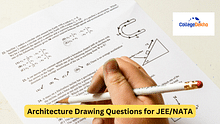
CAT 2023 DILR Practice Questions with Answers: The CAT DILR section is often seen as the trickiest part of the exam. Unlike other sections, it doesn't have a clear syllabus, which can make it seem difficult. Even though the CAT 2023 syllabus is vast, regular practice will help you learn the tips and tricks needed to solve these questions.
The CAT 2023 exam is being conducted today, November 26, 2023, and candidates can find detailed analysis, question paper and more below:
| CAT Slot 1 Question Paper 2023 | CAT 2023 Question Paper Analysis Slot 1 |
| CAT Slot 1 Answer Key 2023 | |
Over the years, the DILR section has become tougher. In the past, it used to have separate Data Interpretation and Logical Reasoning problems. Data Interpretation was about working with numbers and graphs, while Logical Reasoning involved puzzles like family trees and grids. But now, it's different. In one hour, candidates will face 8 challenging puzzles and often end up getting confused between DI and LR questions.
In this article, we've included essential CAT DILR practice questions with answers. These are meant to help candidates assess their skills and get accustomed to the question patterns.
Also Read:
| How Much Time is Required to Prepare for CAT 2023? | How to Use Calculator in CAT 2023 |
|---|---|
| How to Solve Parajumble Questions in CAT 2023 | |
Top CAT 2023 DILR Practice Questions with Answers
Here are a few top CAT 2023 DILR practice questions and answers to help you ace the section:Problem Statement 1
Sixty-four players, ranging from seed 1 to seed 64, took part in a single-elimination tennis competition. Seed 1 holds the top position, while seed 64 holds the bottom. The tournament unfolds across six stages: the first round, second round, third round, quarterfinals, semifinals, and the final showdown.
In the initial round, the player with the highest seed (seed 1) engages in Match No.1 against the player with the lowest seed (seed 64). This pattern continues as the second highest seed (seed 2) faces off against the second lowest seed (seed 63) in Match No.2, and so forth. The subsequent rounds follow a similar structure, with winners progressing to the next stage.
Now, let's dive into the questions:
Question 1: If the player seeded 43 emerges victorious, which of the following players cannot be the runner-up?
- Player seeded 44
- Player seeded 45
- Player seeded 46
- Player seeded 36
Question 2: Who might be the lowest seeded player competing against the player seeded 12 in the finals?
- 57
- 59
- 62
- 63
Question 3: If a match features players seeded 23 and 46, which of the following pairs could engage in another match in the tournament?
- 9 and 13
- 6 and 18
- 5 and 51
- 17 and 15
Question 4: With only five upsets in the tournament, who has the potential to be the lowest seeded player winning the entire competition?
- 16
- 17
- 63
- 32
Solutions (Questions 1 to 4)
Solution to Question 1: The diagram above indicates that if the player seeded 43 advances to the finals, the player seeded 46 is precluded from reaching the final since they occupy the same half of the draw. In each half of the draw, only one person progresses to the finals.
Answer: Choice 3
Solution to Question 2: Given the presence of the player seeded 12 in the top half of the draw, the lowest seeded player in the bottom half, i.e., the player seeded 63, has the potential to compete with them in the final.
Answer: Choice 4
Solution to Question 3: Dividing the above diagram into four sections, with 46 falling into the third part and 23 into the fourth part, it follows that, apart from players seeded 23 and 46, none of the players in the third or fourth part can engage in a match with those in the other three groups. Consequently, only the match between players seeded 9 and 13 is plausible among the given choices.
Answer: Choice 1
Solution to Question 4: To secure victory in the tournament, any player must triumph in six matches. With five upsets in play, the player seeded 32 has the potential to emerge as the tournament winner.
Answer: Choice 4
Problem Statement 2
Amit, Basheer, Chris, Dharam, and Esso comprise a group of five friends, each with a distinct height. They are assigned position numbers based on their heights, ranging from 1 for the tallest to 5 for the shortest.
The sum of Amit's position number and Esso's position number equals the sum of Dharam's position number and Chris' position number. Notably, Chris is not the shortest, and Amit is not the tallest. Furthermore, Chris is shorter than Amit, and Dharam is shorter than Basheer.
Now, let's address the questions:
Question 5: Who is the tallest?
- Basheer
- Amit
- Esso
- Either Basheer or Amit
- Cannot be determined
Question 6: If Dharam is shorter than Chris, then the sum of the position numbers of which of the following combinations is/are a perfect square?
- Basheer and Amit
- Dharam and Esso
- Chris and Basheer
- More than one of the above
- None of the above
Question 7: If Dharam is shorter than Chris, then which of the following is true?
Arrange individuals based on their height in descending order, ensuring that individuals with names starting with consecutive letters in the alphabet are not positioned next to each other.
- The sum of the position numbers of Chris and Amit is equal to the position number of Esso.
- The sum of the position numbers of Dharam and Esso is a prime number.
- Basheer is not taller than Chris.
- None of the above
Solutions (Questions 5 to 8)
Amit falls short of being the tallest, and Chris doesn't hold the title of the shortest. Furthermore, Amit surpasses Chris in height, and Basheer outstrips Dharam. Given that Chris is shorter than Amit but not the briefest in stature,
- Amit cannot be assigned the position number 5.
- Similarly, Chris cannot occupy the position number 2.
- Basheer cannot be the most diminutive, given his stature surpasses Dharam's. Dharam, therefore, cannot hold position number 1.
This leads us to the possibilities:
Amit (A) —> 2, 3
Basheer (B) —> 1, 2, 3, 4
Chris (C) —> 3, 4
Dharam (D) —> 2, 3, 4, 5
Esso (E) —> 1, 2, 3, 4, 5
Now, A + E = C + D.
However, C can only be 3 or 4, and neither A nor D can be 1.
Thus, C + D = (3 + 2) or (2 + 3) is not viable, leaving A + E as (1 + 4) or (4 + 1), and A cannot be 1 or 4.
Therefore, C + D = 3 + 4 is feasible.
Hence, A + E = 2 + 5 (Equation 1)
Similarly, C + D = 4 + 3 (Equation 2)
This establishes that Basheer is 1" in both scenarios.
Answer to Question 5: Basheer is the tallest. Choice (1)
Answer to Question 6: Chris + Basheer = 3 + 1 = 4 = (2). Dharam + Esso = 4 + 5 = 9 = 3. Choice 4
Answer to Question 7: Statement (1) is false, as the arrangement is as follows:
Statement (2) is true since Chris + Amit = 3 + 2 = 5 = Esso’s number. Choice 2
Problem Statement 3
In a store, five articles—P, Q, R, S, and T—are available for sale at distinct cost prices and selling prices, ranging from Rs. 650 to Rs. 900. Each article has a unique cost price and selling price, and no article is sold at the same price it was acquired. Key information is provided through the following statements:
(1) The cost price of article R matches the selling price of article T, and both incurred a loss during their sale.
(2) The cost price of Q exceeds that of S, and the shopkeeper garnered a profit from selling Q.
(3) The profit from selling any article surpasses Rs. 350, and the profits on different articles are not identical. Similarly, the losses incurred on any two articles are distinct.
(4) Profit was realized on only two articles, and the profit or loss on any article is not Rs. 150.
Now, addressing the questions:
Question 8: What is the selling price (in INR) of article P?
- 700
- 750
- 850
- 900
Question 9: What is the difference (in INR) between the cost price and the selling price of article Q?
- 50
- 250
- 200
- 100
Question 10: Whose selling price is INR 3700?
- Q
- R
- S
- T
Question 11: Which of the following statements is true?
- The selling price of S is INR 3700.
- The profit from selling P is INR 3200.
- The cost price of T is not INR 3750.
- None of these
Solutions (Questions 8 to 11)
Given a profit greater than 50 and a profit at 150, we can deduce that the profits can take any two values among 100, 200, and 250. If one of the profits is 250, the other profit cannot be 200.
Considering that 250 equals 900 minus 650 and 200 equals either 850 minus 650 or 900 minus 700, the latter scenario is not feasible.
One profit is 100, and the other is 200/250. Also, 100 equals 750 minus 650 or 850 minus 750.
Since neither R nor T made a profit, and the selling price or cost price of the article on which a profit of Rs. 100 was made is not Rs. 750, denoted as a ≠ 750. As a + > a > a − , a ≠ 650, 900, therefore a can only be 700 or 850.
Similarly, for b + > b > b − , b ≠ 650, 900. If b equals 850, then b + must be equal to 900, leading to a profit of Rs. 50, violating condition (3). Therefore, b can only be 700 or 750.
Considering the profit is greater than Rs. 350 and not equal to Rs. 3150, the possibilities for (b, b + ) are (700, 900) and (750, 850).
If a equals 850, then a + must be equal to 900. Also, (b, b + ) equals (700, 900), meaning a profit of 200 is made on selling Q.
Therefore, b − must be equal to 650, resulting in a profit of 100 on selling S, and the selling price of S must be 900, as the profits on no two articles are the same. Consequently, the selling price of P is Rs. 750.
Condition (4) indicates that the cost price of P cannot be Rs. 3900. Thus, the cost price of P is Rs. 3850, and that of T is Rs. 900.
Hence,
Answer to Question 8: Choice 2 is accurate, as the selling price of P is INR 3750.
Answer to Question 9: The correct difference is 250, as calculated by subtracting 650 from 900. Choice 2 stands correct.
Answer to Question 10: Choice 4 accurately states that the selling price of T is INR 3700.
Answer to Question 11: The only true statement is Choice 3.
Problem Statement 4
In a family of eight members—P, Q, R, S, T, U, V, and W—spanning three generations, there are three married couples, and two individuals remain unmarried. Each couple has at least one child. Within this family, each person is employed by one of the companies: A, B, C, D, E, F, G, or H, with no repetitions.
V and F are the only siblings in the family, while U, W, R, and S share the same gender. Notably, W and V are not a married couple.
The individual working with A is the mother of the individual working with F, who is a female. V, who is not employed by E, has a daughter named S. R is employed by B. The person working with G and the person working with E belong to the same generation. The person working with G is a female, whereas the person working with E is a male. The individual working with C is the maternal grandfather of Q, who, in turn, works with D. Finally, T is employed by H.
Now, let's address the questions:
Question 12. At which company is W employed?
- H
- G
- F
- A
Question 13. Who is the spouse of the individual working with E among the following?
- R
- S
- W
- The individual working with E is unmarried.
Question 14. Among the options, which pairs of individuals are confirmed to be a married couple?
- V and U
- S and T
- R and T
- none of the above
Question 15. Which of the following statements is true?
- U is employed at A.
- W is P's daughter.
- Q is male.
- none of the above
Solutions (Questions 12 to 15)
Given the following conditions:
(1) The 8 family members span three different generations.
(2) The family consists of three married couples, with two unmarried individuals.
(3) Each married couple has at least one child.
From these conditions, two possibilities arise. The family members are labeled as F1, F2, ..., F8.
Let's explore possibility (I):
V and R are identified as the only siblings. Assign F3 as V and F4 as R. V has a daughter, 8, making F7 S. Consequently, U, W, R, and S are females. The person working with C is Q's maternal grandfather, so F8 is Q, who works with D, while F1 works with C. R works with B.
The person working with A is the mother of the person working with F, and both are females. F5 (V's wife) works with A, and her daughter works with F. However, this setup conflicts with the condition that the individuals working with G and E must be of the same generation. Therefore, this case is not viable.
Consider possibility (II):
This possibility has two sub-cases:
Case (a): F2 is R. In this scenario, F3 is V, and F, is the individual working with C. F6 is S, F8 is Q, and F4 is U, who works with A. This arrangement places F7 and F5 in E and G, respectively. However, V working with H is not feasible, rendering this case invalid.
Case (b): F2 is V. F3 is R, and V works with C. F5 is S, F8 is Q and works with D. As W is not V's spouse and is female, she can't be F4 or F7. Hence, F6 is W, F1 is U working with A, and S works with F. The individuals working with G and E must be in the same generation, leading to W working with G and F7 working with E. F4 works with H, so F4 is T, and F7 is P.
The final arrangement is as follows:
Answer to Question 12: W works with G. Answer: Choice (2)
Answer to Question 13: S is the wife of the person who works with E. Answer: Choice (2)
Answer to Question 14: V and U are a married couple, and so are R and T. Answer: Choice (4)
Answer to Question 15: Only choice (1) is true. Answer: Choice (1)
How to Prepare for CAT DILR
Here are some top articles to help candidates prepare for the DILR section in the upcoming CAT exams.| Tips to Answer Logical Reasoning Questions in CAT 2023 | How to Prepare for CAT DILR 2023 |
|---|---|
| CAT DILR Syllabus 2023 | |
In conclusion, the CAT Data Interpretation and Logical Reasoning (DILR) section can be challenging for many aspirants due to its lack of a defined syllabus and evolving difficulty over the years. However, consistent practice is the key to mastering this section. As the distinction between Data Interpretation and Logical Reasoning has diminished, candidates need to adapt to solving high-quality puzzles efficiently. This article provides essential practice questions to help candidates familiarize themselves and navigate the complexities of the DILR section, ultimately guiding them to success in the CAT exam.
Related Links:
| Types of Reading Comprehension Questions in CAT 2023 | Section-wise Time Management Tips for CAT 2023 |
|---|---|
| Toppers Tips for CAT 2023 | Importance of Vedic Math in CAT 2023 |
We hope the above article was useful in providing a better understanding of the questions given in the CAT DILR section. For any further queries, feel free to post your questions in our CollegeDekho QnA section or call us at 1800-572-9877.

















Similar Articles
Christ University BBA Admissions 2024: Registration (Started), Exam Dates (Out), Pattern, Syllabus, Admit Card
XAT Score vs Percentile 2024: Official Cut off, Score Predictor
Top MBA Entrance Exams 2024 in India: Dates, Registration, Top Colleges
MBA Admission 2024 (Open): Application Dates, Entrance Exams, Admission Process & Top Colleges
List of Top 10 MBA Specialisations in 2024: Choose the Best One
CMAT Important Topics 2024 - Section-wise Weightage